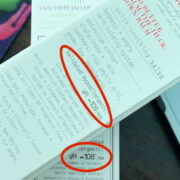A reaction is a reaction…isn’t it?
Yes, in that a skin reaction usually looks and feels “off.” No, in that a skin reaction can be irritant or allergic. Some substances can be irritants but not allergens (such as the iodine on the bottom right of the photo above) or allergens but not irritants (such as the lemongrass essential oil on the top left of the photo above). Always trust your dermatologist to make the diagnosis, but this is a quick overview to help you understand the difference between the two:
Irritant
An irritant reaction is a form of contact dermatitis but it is not an allergic response. According to DermNet NZ, “Irritant contact dermatitis is a form of contact dermatitis, in which the skin is injured by friction, environmental factors such as cold, over-exposure to water, or chemicals such as acids, alkalis, detergents and solvents.”
Irritant reactions have a relationship with the concentration of the ingredient in a product, the frequency of your skin’s exposure it, and how long your skin is exposed to it. While a diagnosis needs to be made by your dermatologist, here are examples of what an irritant reaction might look like:
- You use a moisturizer most of your life and experience relatively mild symptoms like dryness that you don’t think of as a reaction, but that are, in fact, mild irritant reactions. If you spread on more of the moisturizer or use it more often, you notice more dryness or possibly other symptoms like redness. If you stop using it for a while, the symptoms subside. And when you use it again, you don’t notice a problem unless you use more of it or use it more frequently.
- Babies often get an irritant reaction from their saliva around the mouth and on the chin. The reaction goes away as they drool less as they get older.
- Temporary burns from strong chemicals like chlorine.
- Itching and redness after touching certain insects.
- Dry, red, itchy skin from winter or dry, cold air.
- An instant redness or itching after applying a certain threshold amount of a cosmetic product (in an allergic reaction, the symptoms would appear regardless of the amount applied).
Allergic
An allergic reaction is a true allergy, meaning that the body has an immune response to an allergen.
You can use something for weeks, months, or years without a problem and then only later develop an allergy to it. This happens once your cells recognize a substance as foreign. After this, on repeat exposure, the allergic reaction occurs even with exposure to small amounts of the allergen (whereas an irritant reaction would require a certain threshold amount to elicit a reaction). If you are allergic to a substance or develop an allergy to it, any percentage of it for any amount of time on the skin will cause a reaction.
Irritant Versus Allergic
The percentage of an irritant or allergen (how much of it was applied or how much of it the skin was exposed to) is important in differentiating irritant and allergic contact dermatitis.
Irritants at a high concentration cause acute irritant contact dermatitis (marked swelling and blistering), such as after just a one-time exposure to a strong acid. At lower concentrations of an irritant and/or constant exposure to it, a chronic irritant contact dermatitis can develop. You might see this in the hands — the skin becomes thick and leathery — of people who work in the health, laundry, or cleaning industries from the frequent exposure to strong soaps and cleaning agents. That said, you could also actually build a tolerance to mild irritants over time.
In allergic contact dermatitis, you may be exposed to an allergen for weeks, or even most of your life, and not react to it. This changes once your skin’s T cells recognize the allergen as “foreign” or “bad,” and develop an immune response then a delayed response that continues every time you are exposed to it from that moment on. Once this immune response is set, any amount of the allergen shortly after contact with your skin will cause a reaction.
An allergic reaction can coexist with an irritant reaction. For example, dryness or redness from the frequent use of alcohol, bleaches, chlorine or other disinfecting products could be an irritant reaction. But if the products also contain fragrances, preservatives, formaldehyde or other top allergens, you might also develop an allergic reaction.
Contact dermatitis experts are the specialists to accurately identify whether the skin changes you are seeing — dryness, redness, dark patches, and other symptoms — are an irritant or allergic reaction. A patch test is important to accurately identify which substance or ingredient is causing the reaction, and patch tests can also confirm if a reaction is allergic or irritant. After you get your patch test results, you’ll know exactly what you need to avoid. And often, just simple and careful avoidance of the substance can give you relief and clarity.
?
Check out the other posts related to contact dermatitis:
Allergen-Not An Allergen
Get A Patch Test Or Photo-Patch Test
On Contact Dermatitis, Sensitive Skin, and Patch Testing: Interview with an Expert
 Laura is our “dew”-good CEO at VMV Hypoallergenics and eldest daughter of VMV’s founding dermatologist-dermatopathologist. She has two children, Madison and Gavin, and works at VMV with her sister CC and husband Juan Pablo (Madison and Gavin frequently volunteer their “usage testing” services). In addition to saving the world’s skin, Laura is passionate about health, inclusion, cultural theory, human rights, happiness, and spreading goodness (like a great cream!)
Laura is our “dew”-good CEO at VMV Hypoallergenics and eldest daughter of VMV’s founding dermatologist-dermatopathologist. She has two children, Madison and Gavin, and works at VMV with her sister CC and husband Juan Pablo (Madison and Gavin frequently volunteer their “usage testing” services). In addition to saving the world’s skin, Laura is passionate about health, inclusion, cultural theory, human rights, happiness, and spreading goodness (like a great cream!)







[…] This is a little tricky but let’s break it down: the most common alcohol (isopropyl, ethyl) used for disinfection is an irritant — and it is certainly drying —but it is not a common contact allergen. For more on the difference between irritant and allergic reactions, see It’s Complicated: Allergic Versus Irritant Reaction. […]
[…] For the difference between irritant and allergic reactions, see It’s Complicated: Allergic Versus Irritant Reaction. […]
[…] For the difference between irritant and allergic reactions, see It’s Complicated: Allergic Versus Irritant Reaction. […]
[…] For the difference between irritant and allergic reactions, see It’s Complicated: Allergic Versus Irritant Reaction. […]
[…] For the difference between irritant and allergic reactions, see It’s Complicated: Allergic Versus Irritant Reaction. […]
[…] For the difference between irritant and allergic reactions, see It’s Complicated: Allergic Versus Irritant Reaction. […]
[…] For the difference between irritant and allergic reactions, see It’s Complicated: Allergic Versus Irritant Reaction. […]
[…] For the difference between irritant and allergic reactions, see It’s Complicated: Allergic Versus Irritant Reaction. […]
[…] For the difference between irritant and allergic reactions, see It’s Complicated: Allergic Versus Irritant Reaction. […]
[…] be found in some cold remedies and liniments. While some reports consider turpentine more of a skin irritant than an actual contact allergen, cases of allergic contact dermatitis to it have been reported, it […]
[…] For the difference between irritant and allergic reactions, see It’s Complicated: Allergic Versus Irritant Reaction. […]
[…] For the difference between irritant and allergic reactions, see It’s Complicated: Allergic Versus Irritant Reaction. […]
[…] For the difference between irritant and allergic reactions, see It’s Complicated: Allergic Versus Irritant Reaction. […]
[…] For the difference between irritant and allergic reactions, see It’s Complicated: Allergic Versus Irritant Reaction. […]
[…] a top contact allergen and does not appear as such in patch test trays, but it can certainly cause contact irritations (especially when scrubbed on skin vigorously). Like dirt and mud, the volcanic rock could possibly […]
[…] For the difference between irritant and allergic reactions, see It’s Complicated: Allergic Versus Irritant Reaction. […]
[…] For the difference between irritant and allergic reactions, see It’s Complicated: Allergic Versus Irritant Reaction. […]
[…] For the difference between irritant and allergic reactions, see It’s Complicated: Allergic Versus Irritant Reaction. […]
[…] For the difference between irritant and allergic reactions, see It’s Complicated: Allergic Versus Irritant Reaction. […]
[…] For the difference between irritant and allergic reactions, see It’s Complicated: Allergic Versus Irritant Reaction. […]
[…] it clogs the pore but also causes irritation (remember, acne in this case is actually a type of irritant contact dermatitis of the follicle) and inflammation. On the other hand, a product that is comedogenic would take […]
[…] This is a little tricky but let’s break it down: the most common alcohol (isopropyl, ethyl) used for disinfection is an irritant — and it is certainly drying —but it is not a common contact allergen. For more on the difference between irritant and allergic reactions, see It’s Complicated: Allergic Versus Irritant Reaction. […]
[…] For the difference between irritant and allergic reactions, see It’s Complicated: Allergic Versus Irritant Reaction. […]
[…] For the difference between irritant and allergic reactions, see It’s Complicated: Allergic Versus Irritant Reaction. […]
[…] allergens. Irritant and allergic reactions are not the same thing (read more about the differences here). Normally, less exposure to an irritant should not be a problem. As long as you’re getting a […]
[…] For the difference between irritant and allergic reactions, see It’s Complicated: Allergic Versus Irritant Reaction. […]
[…] For the difference between irritant and allergic reactions, see It’s Complicated: Allergic Versus Irritant Reaction. […]
[…] are relatively few case reports of allergic contact dermatitis to it. Benzoyl peroxide can be an irritant, however (why so many people find products containing it […]
[…] For the difference between irritant and allergic reactions, see It’s Complicated: Allergic Versus Irritant Reaction. […]
[…] For the difference between irritant and allergic reactions, see It’s Complicated: Allergic Versus Irritant Reaction. […]